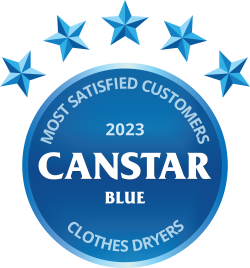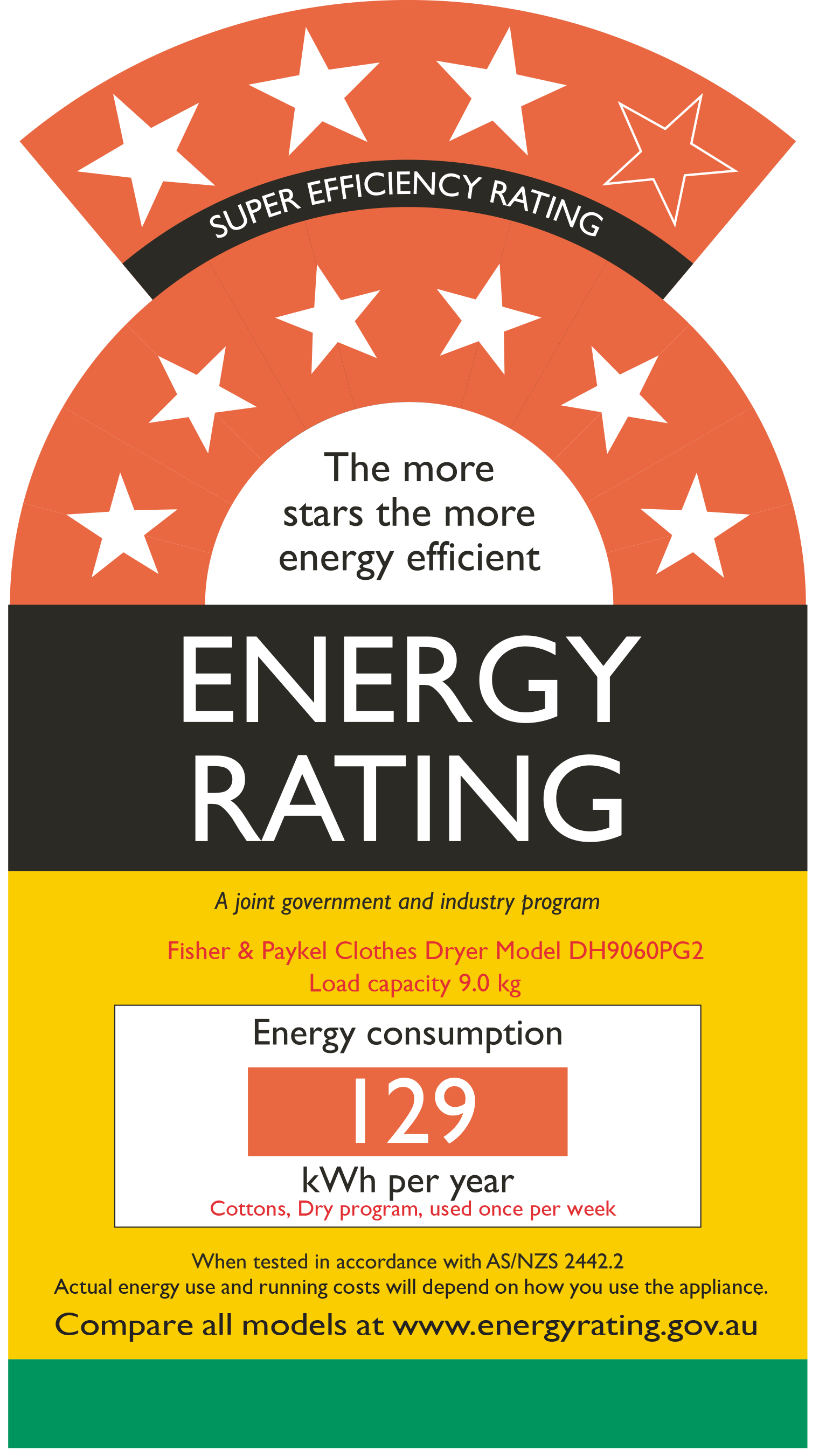If you’re in the market for a new clothes dryer, apart from discovering the best appliance brand, what do you need to consider before making your purchase? Canstar Blue walks you through all you need to consider when buying a new clothes dryer.

Canstar’s Best-Rated Clothes Dryers
If you’re considering purchasing a new dryer and are looking for the best brands, Canstar Blue can help. Each year we survey hundreds of Kiwi consumers about their clothes dryer purchases to discover which brand delivers the best customer satisfaction and value for money.
This year, our researchers spoke to 492 Kiwis who had bought a clothes dryer, and out of the top five dryer brands surveyed – Bosch, LG, Fisher & Paykel, Samsung and Haier – one brand took out our top award: Bosch.

It’s not the first time Bosch has won our Clothes Dryer Award, and once again the German appliance manufacturer earned a remarkable set of ratings from its happy customers.
Here in NZ, Bosch sells a range of eight heat-pump dryers, across three Series: 3, 6 and 8. Prices start from around $1300 for a Series 4, 8kg dryer and reach as high as $3299 (approx) for a Series 8 9kg model.
All Bosch dryers feature auto-dry sensing, while more expensive models boast no-lint auto-cleaning and smart connectivity. Energy ratings vary between models, from seven up to an impressive 10 stars, for the 8 Series, 8kg dryer.
For more on Bosch’s win and our latest dryer awards, click the button below:
Canstar Blue's Best-rated Dryers Award!
Best Dryers in NZ: Full Buying Guide. In this article we cover:
- Dryer capacity
- Type of dryer
- Choosing an energy-efficient dryer
- Other features to consider
- Which fabrics are safe to put in a dryer?
Dryer capacity
The first step when buying a clothes dryer is working out the size you need. Do you have a large family, and how much clothing do you need to dry on a regular basis? Most dryers have a capacity of between 4-10kg, however, if you’ve got no clue about your needs, consider these two tips:
- A rough rule of thumb is that the capacity of your dryer should be double that of your washing machine. While you don’t need to aim for exactly double, your dryer needs to be quite a bit larger than your washing machine.
- When a dryer states its capacity in kg, that refers to the weight of the clothes once dry. Not while they’re damp, straight out of the washing machine.
Also, consider the following:
- 1 to 2 people: <5kg
- 3 to 4 people: 5-7kg
- 4-plus people: >7kg
Type of dryer
Once you’ve settled on the size of dryer you require, you need to consider the type of machine you want to buy:
Vented dryer
Vented dryers are the simplest form of dryer. They heat air, pass it into the drum, and then vent it, often outside via a hose. Vented dryer capacity ranges from 3kg to 9kg. Prices start from as little as $500.
Pros:
- Generally cheaper to buy
- Dries clothes quickly
- Can be cheaper to run than a condenser dryer
- Can be wall mounted
Cons:
- Because they expel moist air, excess moisture can lead to damp and/or mould on walls and around the dryer
- Needs to be near a window/external wall for the hose to expel moist air outside
- Can be expensive to run
- Requires an open and well-ventilated space, so not ideal for use in an apartment, etc, that has a laundry closet
Condenser dryers
Condenser clothes dryers recycle hot air by extracting the water vapour from it. The dry air is then sent back through the clothes in the dryer, while the water is either collected in a tank or expelled into the drain via a hose.
While this method of dealing with moist air means no humidity in your laundry room, it doesn’t do anything for the heat itself, meaning your laundry will be just as warm as if you were using a vented dryer.
Condenser clothes dryers cost from around $650 upwards.
Pros:
- As excess moisture is not vented, condenser dryers can be placed just about anywhere, although their water tanks need to be emptied, if not plumbed in
- Typically comes with more settings and features than a vented dryer
Cons:
- Generally more expensive to purchase than a vented dryer
- Too heavy to be wall-mounted, but can be stacked on a front-loading washing machine
- Can cost more to run, and dries clothes more slowly than a vented dryer
Heat-pump dryers
A heat-pump dryer is a type of condenser dryer, which recycles heat in the process of extracting moisture. This means you get great drying results while consuming up to 50% less electricity than other dryer types. Prices start from around $1300.
Pros:
- Extremely energy efficient
- Heat-pump dryers don’t vent heated air or water vapour, so no heat or humidity for your laundry room
- Uses lower temperatures and therefore gentler on clothes
Cons:
- Higher purchase price
- Slower to dry clothes than vented or condenser dryers
Washer dryers
You can also get a washer dryer combo that combines a front loader washer and a dryer in one compact machine. The dryer will typically be a condenser/sensor dryer, that can automatically switch off once it senses the clothes are dry. Prices range from around $900 to over $2500.
Pros:
- Incredibly compact and convenient, ideal for small spaces
Cons:
- A cycle can take a long time
- Some washer dryer combos use a lot of water
- The performance is not always comparable with a separate washer and dryer

Choosing an energy-efficient dryer
When choosing a dryer, energy efficiency is an important consideration, one that can save you a considerable amount of money over the lifetime of your appliance.
As we mention above, a third of respondents in our survey say that their choice of dryer was heavily influenced by its energy-saving rating.
Finding an energy-efficient dryer is simple. Just check its Energy Rating Label (see right). The more stars, the more energy-efficient the dryer.
The label also shows an estimated kWh usage per year, which if you know how much you’re paying for power, can help you work out the dollar cost of using the dryer.
Keep in mind that cheap and basic appliances tend to be less energy-efficient. So to lower your running costs, you’ll likely have to raise your upfront costs. However, as a dryer is one of the costlier appliances to run, choosing an energy-efficient model is a wise investment.
How much electricity does a clothes dryer use?
There is a big difference in the amount of electricity dryers use. A 2-star model can burn through close to 7kWh per load, while a 10-star model uses around 2kWh.
This means there’s a big difference in their running costs. The following calculations show running costs according to current government energy ratings, which assume one cotton load per week.
To do the calculations below we’ve used the national average power price of 32.5c p/kWh.
| Energy star rating | Machine Load | Per Year Energy Use | $ Per Year | $ Per Load |
| 10 Stars | 9kg | 105kWh | $34.12 | $0.66 |
| 9 Stars | 9kg | 129kWh | $41.93 | $0.81 |
| 8 Stars | 9kg | 145kWh | $47.13 | $0.91 |
| 7 Stars | 8kg | 159kWh | $51.68 | $0.99 |
| 2 Stars | 8kg | 355kWh | $115.38 | $2.22 |
As you can see, if you buy a cheap 2-Star energy rated dryer, instead of a more efficient one, you’ll be paying a lot more to use it, especially if you’re running it more than once per week.
Over 10 years on the above numbers, a 2-star 8kg dryer will cost $813 more to run than a larger 9kg 10-star dryer.
Other tips to get your dryer running more efficiently include:
- Avoid leaving it on standby, turn it off at the wall
- Avoid drying loads of laundry that are too small or too large. Too small and it’s wasteful; too large and clothes won’t ventilate and dry efficiently, as the warm air needs to be able to move through the clothes
- Use dryer balls to speed up dry time. Dryer balls absorb moisture while also tumbling through the dryer, separating clothes and improving the ventilation through the washing
- Switch loads while the dryer is still warm
- Dry heavyweight items separately. The dryer will continue to run until the heaviest items are dry, meaning any small items included will dry longer than necessary
- Use features, such as a cool-down cycle, which finishes drying with the remaining heated air left in the dryer
Finding the best power provider
While energy-efficient appliances are a great way to save you money, you also need to be getting a good deal on your power. And, ultimately, finding affordable power involves shopping around.
When comparing power companies, it’s important to consider the broader picture – don’t become too focused on finding a deal with a big prompt payment discount or special perk. Be sure to balance all the rates, discounts, fees and contract periods when making a decision, as well as more personal factors, such as customer service and support.
Compare with Canstar Blue
To help you find the best value electricity retailer, Canstar Blue rates NZ power companies for customer satisfaction and value for money, see the table below for some of the results, or you can click on the button below for the full results of our survey.
Canstar Blue’s latest review of NZ power companies compares them on customer satisfaction. The table below is an abridged version of our full results, available here.
^ By clicking on a brand or 'details' button, you will leave Canstar Blue and be taken to either a product provider website or a Canstar Blue NZ brand page. You agree that Canstar Blue NZ’s terms and conditions apply (without limitation) to your use of this service,to any referral to a product provider from our website, and any transaction that follows. Canstar Blue may earn a fee for referrals from its website tables, and from sponsorship (advertising) of certain products. Payment of sponsorship fees does not influence the star rating that Canstar Blue awards to a sponsored product. Fees payable by product providers for referrals and sponsorship may vary between providers, website position, and revenue model. Sponsorship fees may be higher than referral fees. Sponsored products are clearly disclosed as such on website pages. They may appear in a number of areas of the website such as in comparison tables, on hub pages and in articles. Sponsored products may be displayed in a fixed position in a table, regardless of the product’s rating, price or other attributes. The table position of a sponsored product does not indicate any ranking, rating or endorsement by Canstar Blue. See How we are funded for further details.
Canstar Blue NZ Research finalised in April 2023, published in June 2023.
See Our Ratings Methodology
Compare electricity providers for free with Canstar Blue!
Other dryer features to consider
- Cycles – some dryers come with a couple of cycles, while others have dozens of cycles and settings for various load types
- Drum design – some dryers come with special drums design to be gentler on clothes
- Sensor – does the dryer run only on a timer, or can it switch itself off once it detects clothes are dry?
- Smart capabilities – allow you to control your dryer from your smartphone and access convenient features, like auto start and stop, or cycles that you can download to your dryer for difficult clothing items
- Temperature controls – to give you precise control over how you dry
- Noise – if your laundry room is separate from your living areas, noise probably won’t be a big deal. If your dryer is in the laundry closet of your small apartment, it might be
Which fabrics are safe to put in a dryer?
Always read and abide by your garment’s care label. And if an item is particularly precious or expensive, maybe just use a clothes horse. However, here’s a guide to which fabrics are safe to use in a dryer.
Acrylic
Usually safe, but should be done on a low heat, as if it’s too high the clothes can permanently wrinkle.
Cotton
100% cotton clothes may shrink if put in a dryer, although most cotton blends should be able to survive the drying cycle shrink-free. But always use a low heat, and it pays to check a garment’s label to see if it has been pre-shrunk.
Denim
Denim fabrics can be put into a dryer. But for optimal care, take them out just before the end of the cycle and leave them finish air drying, as they’ll keep their shape for longer. Use a low-heat and delicate cycle if using a tumble dryer, as well as low heat if you have crinkles to iron out.
Linen
Most linen options, such as towels and sheets, are dryer safe. Although tumble drying may impact the lifespan of the linen. Use a low temperature, and be mindful that linen can be prone to wrinkling.
Linen clothing, however, is a different story. Many garment manufacturers recommend linen clothing to be professionally dry cleaned or air-dried, to avoid shrinkage and creasing.
Microfibre
Microfibre-made clothes and covers should be fine, as long as the dryer is set to a low temperature, as microfibre dries quickly in comparison to other materials. It’s also recommended to dry with other microfibre products to prevent lint from building up.
Nylon
Most nylon clothes should be dryer safe. But, as nylon dries quickly, it’s recommended that nylon is put through a low-temperature cycle. Also grab the clothes out of the machine as soon as possible, as they can be damaged if left in the dryer too long. Nylon also builds up static cling, so be sure to dry with a dryer sheet to avoid getting zapped.
Polyester
Polyester is quick-drying, so you may not even need to use a clothes dryer. But, for peace of mind, you won’t ruin your clothes if you do use a machine. Using a low-temperature cycle will also avoid any possible damage or shrinkage. Again, beware the static!
Spandex
As spandex is often mixed with other fabrics, you’ll have to check your clothes’ tags before you throw them in the dryer, as some spandex clothing may be fine to dry, while others are best hung out to dry. Generally, the more spandex your clothes contain, the more possible dryer damage.
Which fabrics shouldn’t go in a clothes dryer?
- Cashmere
- Wool
- Lace
- Silk
- Leather & suede
- Rayon
Compare electricity providers for free with Canstar Blue!

About the author of this page
This report was written by Canstar’s Editor, Bruce Pitchers. Bruce has three decades’ experience as a journalist and has worked for major media companies in the UK and Australasia, including ACP, Bauer Media Group, Fairfax, Pacific Magazines, News Corp and TVNZ. Prior to Canstar, he worked as a freelancer, including for The Australian Financial Review, the NZ Financial Markets Authority, and for real estate companies on both sides of the Tasman.
Enjoy reading this article?
You can like us on Facebook and get social, or sign up to receive more news like this straight to your inbox.
By subscribing you agree to the Canstar Privacy Policy


Share this article